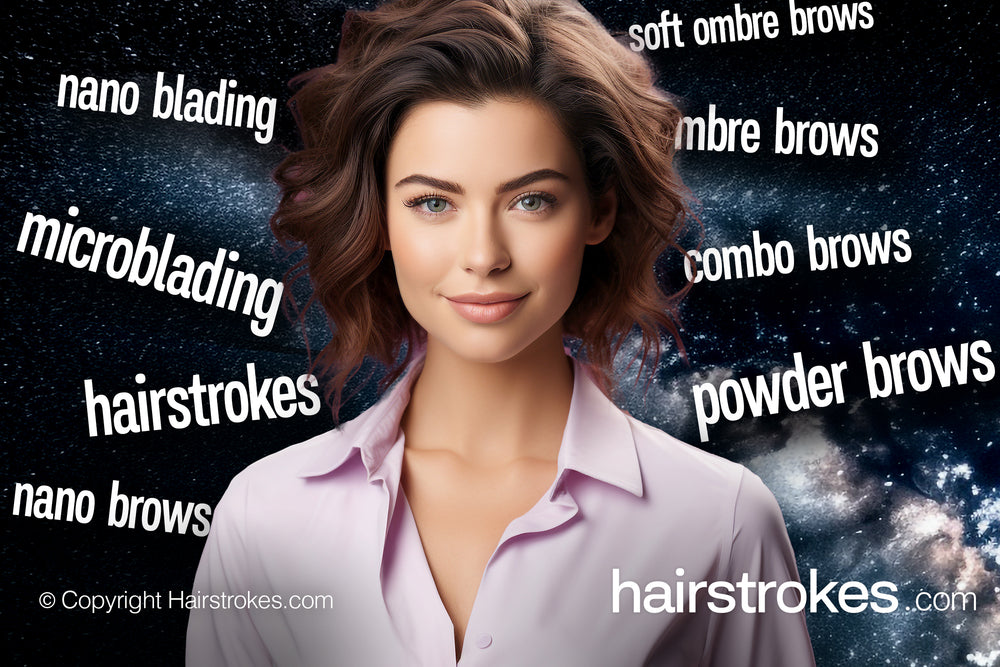The term "hairstrokes" is sometimes utilized in contexts that are not entirely accurate. Let's delve into its actual meaning. Broadly speaking, "hairstrokes" refers to fine lines or markings that simulate the appearance of natural hair. This term is prevalent in various artistic realms, such as drawing, painting, and digital graphics, where the objective is to produce lifelike, hair-like strokes. These strokes can differ in thickness, length, and curvature to mirror the natural diversity found in human or animal hair.
Hairstrokes in Semi-Permanent Pigmentation
In semi-permanent pigmentation, especially within the beauty and cosmetic industry, "hairstrokes" originally denoted any technique resembling hair-like pigmentation, contrasting with full brow tattooing or powder brows. Around the time microblading emerged in 2014, many artists described microblading as "hairstrokes made with a blade" or used the term for hairline style lines crafted with a pigmentation machine.
However, over the years, the term "Hairstrokes" has evolved to specifically denote brow hair patterns created with a pigmentation machine, typically using a single needle and occasionally other needle configurations. This distinction reflects the technique's focus on replicating individual brow hairs for a natural, refined appearance.
Hairstrokes and Powder Brows
Referring to hairstrokes as a variant of powder brows is somewhat misleading. However, they share a significant commonality: both techniques typically utilize a pigmentation machine and often employ a needle cartridge (though hairstrokes may occasionally be done with a nozzle needle). This means that proficiency with a pigmentation machine is crucial for creating hairstrokes.
However, artists specializing in hairstrokes and many leading powder brow practitioners concur that hairstrokes are more nuanced and complex than traditional powder brows or any derivative where the brow is filled with powdering. Specifically, hairstrokes is a technique that involves crafting a complex pattern of various stroke elements with the machine, utilizing a combination of lines and shading styles. This distinction underscores the intricate nature and artistic finesse required for executing hairstrokes effectively.
Three Generations of Hairstrokes
Seasoned artists often describe the evolution of hairstrokes through three distinct stages or eras: fence design, hyperrealism, and modern hairstrokes. Initially, with the rise and spread of powder brows, the first era of hairstrokes emerged. Sometimes called the "fences pattern" or "fence design," this style predominantly consisted of nearly vertical parallel lines crudely added to powder brows to simulate natural hair. By today's standards, this method offers a subpar quality of brows.
The second era of Hairstrokes was marked by an influx of new artists with exceptional artistic skills, often utilized to create brows that mimicked natural hair with remarkable accuracy. This period is known for focusing on hyperrealistic brows, resembling overgrown natural brows. However, due to the intense realism, only a fraction of clients were bold enough to opt for this style.
The third and likely final phase of hairstroke's evolution began around 2023. It was significantly influenced by numerous microblading artists migrating to hairstrokes, recognizing the oversaturation of the microblading market and the unfeasibility of a perpetual retouching cycle with microblading. These artists brought commercial savvy to the technique, shifting away from the aim of hyperrealistic, overgrown brows to a bold and groomed appearance. They introduced various commercially viable and slightly modified patterns that balanced looking natural and appealing to a broad customer base. This shift underscores the most substantial connection and influence between hairstrokes and microblading, marking a new era in semi-permanent eyebrow techniques.
The Positive Aspects of Hairstrokes
The "third generation" of Hairstrokes is praised for combining the best elements of both worlds: the natural look akin to microblading and the retention qualities of powder brows. This combination gives Hairstrokes a significant technical advantage over microblading in retention.
The "Natural" and "Artistic" Factor
Empirical research has highlighted another critical strength of Hairstrokes: their lasting nature. While powder brow artists might justify turning away clients' requests for patterns by rightly pointing out unsuitable skin characteristics like oiliness and pore size that would lead to blurred lines in microblading, this explanation doesn't hold when comparing powder brows with Hairstrokes. Indeed, some clients may have a fixed preference for either "pattern" or "powder." While both are generally achievable with fresh, healed, and perpetual retouching cycle images of different techniques, many clients intuitively opt for the third generation of Hairstrokes over other methods. This preference has been substantiated in two studies conducted in 2023. Although research is ongoing, this trend is pronounced and should prompt reflection among microblading and powder brows artists.
Negative Aspects of Hairstrokes
The negative aspects of Hairstrokes are primarily centered around three significant challenges. Firstly, the learning curve is notably steep. Aspiring artists must not only possess technical skills associated with powder brows and an understanding of patterns akin to microblading, but they must also acquire an entirely new set of skills. These include selecting the correct pattern, creating a complex structure of loose regions within the brows, connecting these regions, generating gradient lines, and mastering horizontal shadowing. To execute Hairstrokes professionally, there's a substantial amount to learn.
Secondly, the success of Hairstrokes heavily relies on the artist's ability to select and modify the pattern to align with the natural hair's structure and growth direction. Sometimes, the inherent shape, length, and curvature of the client's natural brow hair can make it challenging to achieve great results with Hairstrokes, a problem less commonly encountered with powder brows.
Lastly, the Hairstrokes procedure itself is more demanding to perform. While seasoned artists might transition to an "auto-pilot" mode when creating microblading or powder brows, this isn't typically feasible with Hairstrokes. The artist must continuously pay close attention, incorporating client-specific details throughout the procedure. This requirement makes the process more time-consuming and energy-intensive than other techniques, demanding more focus and precision from the practitioner.



